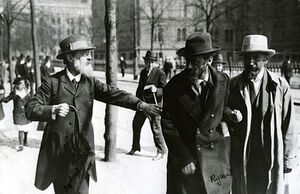Mensheviks
 Leaders of the Menshevik Party in Stockholm, Sweden, May 1917 (Pavel Axelrod, Julius Martov, and Alexander Martinov) | |
| Formation | 1903 |
| Extinction | 1923 |
| One of the three dominant factions in the Russian socialist movement before 1917, tending to be more liberal. | |
The Mensheviks, also known as the Minority[1][2] were one of the three dominant factions in the Russian socialist movement, the others being the Bolsheviks and Socialist Revolutionaries.
The factions emerged in 1903 following a dispute within the Russian Social Democratic Labour Party (RSDLP) between Julius Martov and Vladimir Lenin. The dispute originated at the 2nd Congress of the RSDLP, ostensibly over minor issues of party organization. Martov's supporters, who were in the minority in a crucial vote on the question of party membership, came to be called Mensheviks, derived from the Russian ('minority'), while Lenin's adherents were known as Bolsheviks, from ('majority').[3][4][5][6][7]
Despite the naming, neither side held a consistent majority over the course of the entire 2nd Congress, and indeed the numerical advantage fluctuated between both sides throughout the rest of the RSDLP's existence until the Russian Revolution. The split proved to be long-standing and had to do both with pragmatic issues based in history, such as the failed Revolution of 1905 and theoretical issues of class leadership, class alliances and interpretations of historical materialism. While both factions believed that a proletarian revolution was necessary, the Mensheviks generally tended to be more moderate, and more positive towards the liberal opposition and the peasant-based Socialist Revolutionary Party.[8]
1917 revolutions
After the overthrow of the Romanov dynasty by the February Revolution in 1917, the Menshevik leadership led by Irakli Tsereteli demanded that the government pursue a "fair peace without annexations," but in the meantime supported the war effort under the slogan of "defense of the revolution." Along with the other major Russian socialist party, the Socialist Revolutionaries, the Mensheviks led the network of soviets, notably the Petrograd Soviet in the capital, throughout most of 1917.
With the monarchy gone, many social democrats viewed previous tactical differences between the Mensheviks and the Bolsheviks as a thing of the past and a number of local party organizations were merged. When Bolshevik leaders Lev Kamenev, Joseph Stalin, and Matvei Muranov returned to Petrograd from Siberian exile in early March 1917 and assumed the leadership of the Bolshevik Party, they began exploring the idea of a complete re-unification of Bolsheviks and Mensheviks at the national level, which Menshevik leaders were willing to consider. However, Lenin and his deputy Grigory Zinoviev returned to Russia from exile in Switzerland on 3 April and re-asserted control of the Bolshevik Party by late April 1917, taking it in a more radical direction. They called for an immediate revolution and transfer of all power to the soviets, which made any re-unification impossible.
In March–April 1917, the Menshevik leadership conditionally supported the newly formed liberal Russian Provisional Government. After the collapse of the first Provisional Government on 2 May over the issue of annexations, Tsereteli convinced the Mensheviks to strengthen the government for the sake of "saving the revolution" and enter a socialist-liberal coalition with Socialist Revolutionaries and liberal Constitutional Democrats, which they did on 17 May. With Martov's return from European exile in early May, the left-wing of the party challenged the party's majority led by Tsereteli at the first post-revolutionary party conference on 9 May, but the right wing prevailed 44–11. From then on, the Mensheviks had at least one representative in the Provisional Government until it was overthrown by the Bolsheviks during the October Revolution.
With Mensheviks and Bolsheviks diverging, Mensheviks and non-factional social democrats returning from exile in Europe and United States in spring-summer of 1917 were forced to take sides. Some re-joined the Mensheviks. Others, like Alexandra Kollontai, joined the Bolsheviks. A significant number, including Leon Trotsky and Adolf Joffe, joined the non-factional Petrograd-based anti-war group called Mezhraiontsy, which merged with the Bolsheviks in August 1917. A small yet influential group of social democrats associated with Maxim Gorky's newspaper Novaya Zhizn (New Life) refused to join either party.
References
- ↑ Radziwill, Catherine. [1915] 1920. "Bulgaria Joins the Great Wars." Pp. 326–32 in The Great Events of the Great War 3, edited by C. F. Horne. New York: National Alumni. p. 328.
- ↑ Aldanov, Mark Aleksandrovich. 1922. Lenin. New York: E. P. Dutton. OL2400504W. p. 10
- ↑ Brovkin, Vladimir N. 1991. The Mensheviks After October. Cornell University Press.
- ↑ Basil, John D. 1983. The Mensheviks in the Revolution of 1917. Slavica Publishers.
- ↑ Antonov-Saratovsky, Vladimir. 1931. The Trial of the Mensheviks: The verdict and sentence passed on the participants in the counter-revolutionary organization of the Mensheviks. Soviet Union: Centrizdai.
- ↑ Broido, Vera. 1987. Lenin and the Mensheviks: The persecution of Socialists Under Bolshevism. Gower.
- ↑ Ascher, Abraham. 1976. The Mensheviks in the Russian Revolution. Cornell University Press.
- ↑ {https://books.google.com/books?id=UYn0p-yL4JgC&pg=PT9